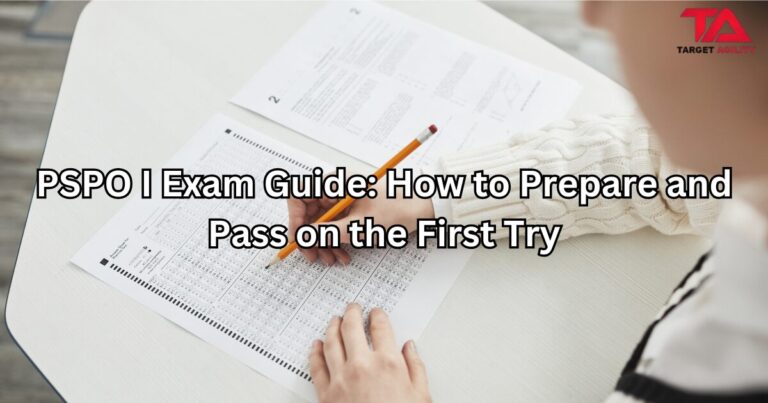The Professional Scrum Product Owner I (PSPO I) certification from Scrum.org is a valuable credential for anyone working in product management or Agile development. It shows that you understand Scrum principles and product ownership.
But how do you pass the exam on the first attempt? This guide will help you with the exam format, key topics, and study tips to ensure success.
1. Know the PSPO I Exam Format
Before studying, understand how the exam works:
- Questions: 80 (Multiple-choice, multiple answers, true/false)
- Time Limit: 60 minutes
- Passing Score: 85% (at least 68 correct answers)
- Open Book: ❌ No
- Retake Fee: 💰 Yes (full payment required)
The exam is timed and tricky, so being well-prepared is key!
2. Study the Scrum Guide Carefully
The Scrum Guide (by Ken Schwaber & Jeff Sutherland) is the most important resource. Since the exam is based on it, you should:
🟢 Read it 3 times to fully understand Scrum.
🟢 Focus on roles, artifacts, and events in Scrum.
🟢 Learn what a Product Owner does and why it’s important.
You can download the Scrum Guide for free from Scrum.org.
3. Understand Key Product Owner Concepts
The PSPO I exam tests your knowledge of:
📌 Managing the Product Backlog – Prioritizing and refining tasks.
📌 Stakeholder Communication – Working with teams and customers.
📌 Delivering Value – Making sure the product meets business goals.
📌 Scrum Framework – Understanding Scrum roles and best practices.
Many people focus too much on backlog management—but Scrum.org expects you to know more than that!
4. Practice with Mock Tests
Mock tests help you:
🟢 Get used to question styles and difficulty.
🟢 Identify weak areas where you need more study.
🟢 Improve time management for the real exam.
Best free & paid practice tests:
📌 Target agility free quiz – Free
📌 Scrum.org Open Assessments – Free
📌 Udemy PSPO I Practice Tests – Paid
💡 Aim for 90% or higher in these mock exams before taking the real test.
5. Read Extra Study Materials
While the Scrum Guide is key, other resources can help:
📖 “Scrum – A Pocket Guide” by Gunther Verheyen – A deeper dive into Scrum.
📖 “Scrum Product Ownership” by Robert Galen – Focuses on the Product Owner role.
📖 Scrum.org Blogs & Forums – Real-world insights from experienced POs.
6. Join Scrum Communities
Learning from others can be very helpful. You can:
💬 Join Scrum.org forums to ask questions.
💬 Participate in LinkedIn & Reddit groups on Agile & Scrum.
💬 Discuss with other PSPO candidates to learn together.
Explaining concepts to others helps you remember them better!
7. Exam Day Tips
To stay confident during the exam:
🟢 Choose a quiet place with a stable internet connection.
🟢 Read carefully – Some questions are tricky.
🟢 Use elimination – Remove wrong answers first.
🟢 Manage time wisely – Spend around 45 seconds per question.
🟢 Double-check your answers before submitting.
Conclusion
Passing the PSPO I exam on the first attempt is possible if you:
🟢 Study the Scrum Guide thoroughly.
🟢 Learn Product Owner responsibilities deeply.
🟢 Take mock tests to improve speed & accuracy.
🟢 Engage with Scrum communities to discuss concepts.
You can click here to earn your PSPO I certification and grow your career in Agile & Product Management! 🚀











